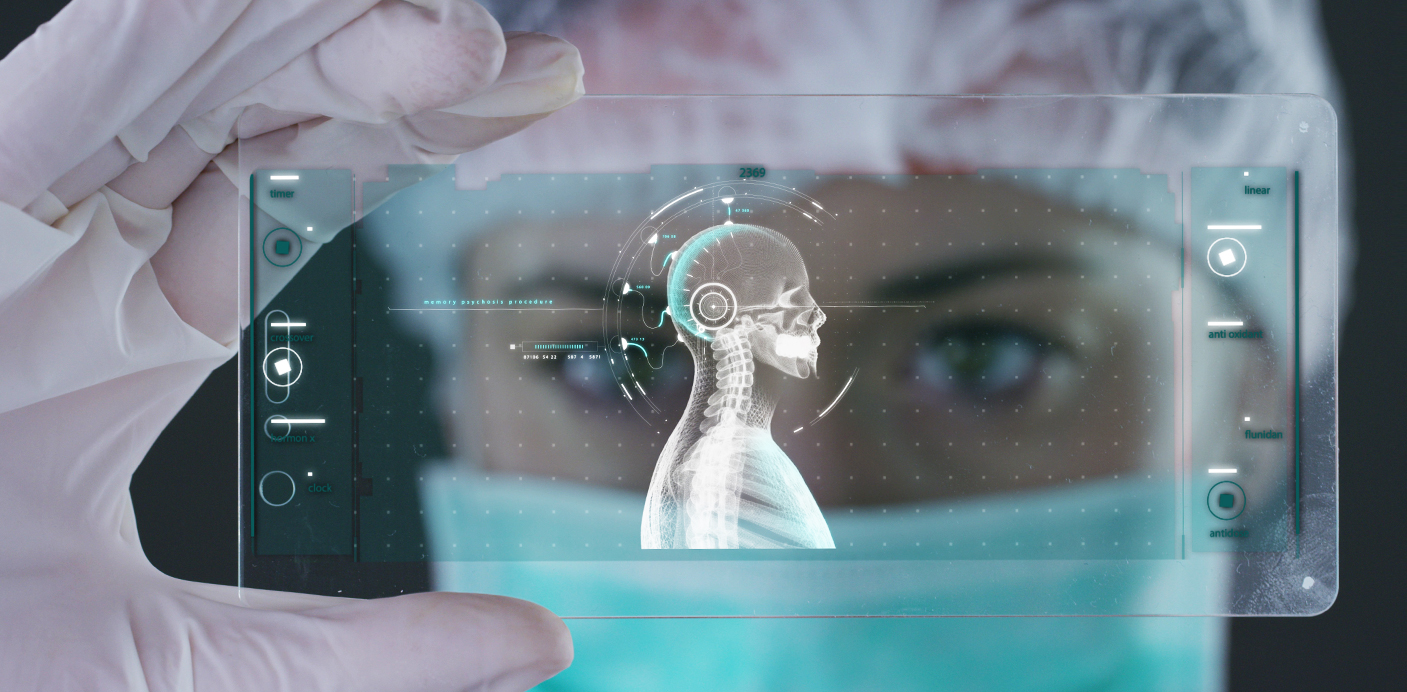VOL.50
March 2019


ICT Trend ____ Digital Content Technology and VR, AR, and MR
Going beyond
VR and AR
toward MR
Digital Content Technology and VR, AR, and MR
So far, you might say what you see is everything that exists around you, or the real world. Going forward, VR and AR applications will open the door to an unknown mysterious world that has existed only in our imaginations. Instead of simply watching and hearing, users will be able to closely experience both the physical and digital worlds, directly or indirectly. Likewise, ICT solutions will provide hands-on experiences using our five senses and stimulate our imagination while overcoming existing temporal and spatial barriers.


VR applications that allow users to experience near real-life situations in a virtual world created by computers
Digital Content Technology Introducing Another World
VR and AR have been very popular recently; VR and AR applications are making headlines on almost a daily basis through news and other media outlets. Also, many exhibitions and theme parks tend to place VR and AR experience halls at the center to attract visitors and tourists. With the paradigm shift in digital content technology, coupled with the transition brought by the Fourth Industrial Revolution, relevant content technologies are facing a watershed moment. Today, content serves as a key medium that connects technology with humans, drawing significant attention. While making our lives more convenient and our experience feel more realistic, digital content technology has already become a central part of our lives, further taking us to another world.
About 20 years ago, the focus of digital content technology was on games. Technology development was primarily associated with PC game engines, game content, game studios, and game testbeds. These game-based content technologies are still being studied. Content technology, once focused on the game industry, has been advancing while moving on to various other themes. The next theme of focus was computer graphics. Researchers attempted to apply creature technology to reproduce physical objects and subsequently emulate the human body, i.e., digital actor technology. Here, the term “creature” refers to a virtual three-dimensional character reproduced with computer graphics, which looks just like an actual image.
It was about 15 years ago that ETRI began to study these creature, nature, and actor technologies as part of its digital content research. With these technologies, it was possible to reproduce highly realistic graphic representations of water, fire, smoke, and explosions. Also, ETRI researchers have been showing their technological prowess in digital content technology, for example, while participating in SIGGRAPH, the world’s most renowned conference on computer graphics. Notably, at the 2007 SIGGRAPH conference, ETRI researchers demonstrated technological prowess that amazed the world and made the cover of the SIGGRAPH Journal, thereby beginning to attract significant attention on the global stage. In early 2000, Dr. In-ho Lee, who led ETRI’s CG research team, established Macrograph, a startup specialized in computer graphics. The company has been vigorously moving forward, for example, recently entering the Hollywood market and the Chinese film market. The focus of content technology has been shifting from computer graphics to VR and AR since 2013, and further to MR more recently.

AR widely used in various fields, such as marketing, transport, and medicine
Hologram Technology That Will Succeed VR, AR, and MR
With the advancement of VR and AR technologies, MR is also expected to advance at a rapid pace. MR allows users to experience an even more realistic world than that of VR. The technology also allows users to not only view through smart glasses but also to see a video display within the glasses, thus making it more attractive to the market. When it comes to VR applications, however, market entry has been relatively slow even though this technology has remained at the center of attention for years. Why? It is because VR applications often exhibit entry barriers. To enjoy VR applications, users need to wear Head Mounted Display (HMD) equipment. The problem is that many people find it uncomfortable to wear such a device on their heads. Female users tend to be more hesitant to use this technology because they fear that their hair and makeup will be ruined or make the device dirty. While watching videos with this HMD device on, some people complain of dizziness or may even vomit.
Furthermore, when wearing HMD equipment, users cannot see in front of them. All these critical disadvantages have been hindering the commercialization of VR technology. Another problem is the resolution. The space between the eyebrows may vary from person to person depending on their facial structure, thereby affecting the fitting of HMD equipment. This may cause a difference in 3D representation of images shown on HMD devices. These physical differences among users may cause different levels of dizziness to occur when using HMD devices. All these problems combined are making it more difficult for VR applications to be accessed in the market, thereby hindering market formation. From a technological perspective as well, these obstacles are difficult to overcome.
Against this backdrop, ETRI researchers are pushing forward with research on VR-AR-MR technologies while keeping pace with national strategic projects. Then, what will be the next big thing? Among various promising technologies, hologram technology may be considered the next focus. The ultimate objective of the technology is to create a hologram using computer graphics and make it interact with humans. Imagine that you have a hologram virtual assistant, who stands beside you, shakes hands and converses with you. In general, a hologram is created using software tools by scanning pictures and converting them into 3D images. The next step is to project the developed hologram and make it interact with other entities so that it can move along with the human user, but this development process is very difficult to implement.

Haptic displays capable of interacting with images through subtle vibrations
Evolution of Content Technology Satisfying Our Five Senses
At ERTI, hologram research is underway not only by the SW•Contents Research Laboratory but also by the ICT Materials & Components Research Laboratory and the Broadcasting and Media Research Laboratory. Hologram research in the realm of digital content slightly differs from other areas. ETRI researchers have so far focused on super multi-view hologram technology. Going forward, the scope of hologram research needs to be extended to not only material and component technology but also interdisciplinary studies covering various fields, such as display, content, natural language processing, voice recognition, haptic technology, and synthetic technology. This approach is key to perfecting hologram technology. Take an AI personal assistant, for example. It would feel even more realistic and affective when your AI assistant is visualized as an image that stands beside your monitor, rather than when heard through smartphones or speakers.
Likewise, the evolution of content technology of today can be characterized by its focus on technologies that satisfy our five human senses. While previous research has focused on allowing users to feel the sense of touch to some extent, much of the current research effort is directed toward technologies associated with the sense of smell. In response, ETRI researchers are developing technology that can reproduce the sense of smell by combining more than 200 types of smells. For example, you only need to wear HMD equipment to feel as if you are walking along the pine forest near the sea in a gentle breeze; here, the technology reproduces the smells of mud flats and pine trees. The objective is to implement digital content technology capable of making users feel as if, for example, they are walking along the beach.
Meanwhile, many international research teams working with content technology are studying the sense of taste. Among others, one example is technology that attempts to immerse users in given display images by planting a chip under their tongues. For example, when an image of a person drinking coffee is shown, the chip will allow the user to taste the flavor of coffee by reproducing and combining various flavors, such as salty, sweet, and sour flavors.
Digital content technology has already been leading the advance of the Fourth Industrial Revolution and will continue to serve as a key growth engine for the future, thereby enriching and fulfilling our lives and taking our national competitiveness to the next level. This transition is already underway, and digital content technology is already one step ahead in the midst of the change.
This article is quoted from Technology That Will Change the World, Future Brought by Digital Technology, ETRI’s Easy IT series (2018).

Future Brought by Digital Technology
Written by Kilho, Chong · ETRI's Superior Public Relations Section Published by Contentshada
Future Brought by Digital Technology issued by ETRI aims to help readers better understand what the Fourth Industrial Revolution means to them and to introduce various ICT trends so that readers can have a fascinating glimpse of what might happen in the near future. This book will be a reliable guide for anyone who wants to learn and understand how to adapt to the rapidly changing, unpredictable world driven by technological innovations and flexibly respond to risks that might be faced going forward.



